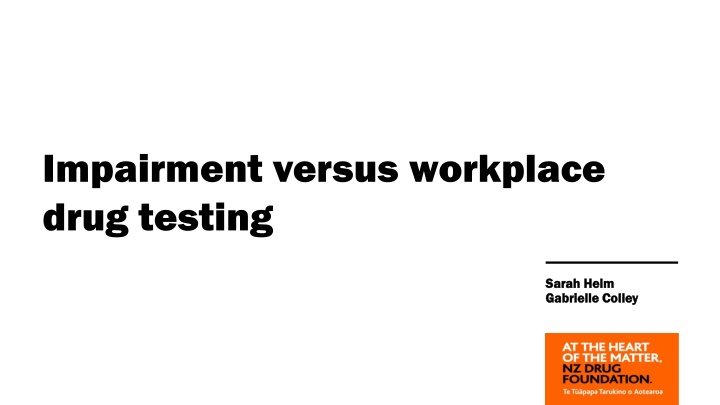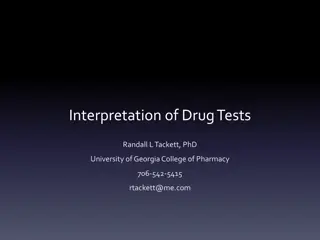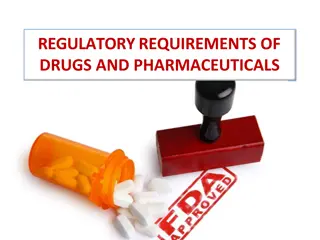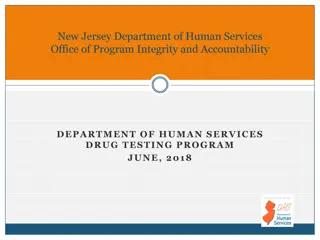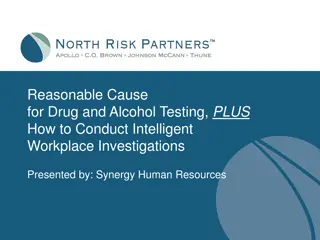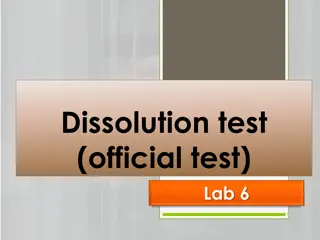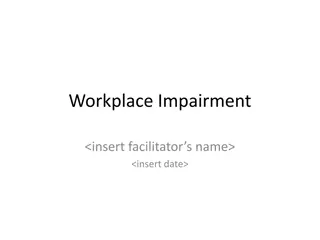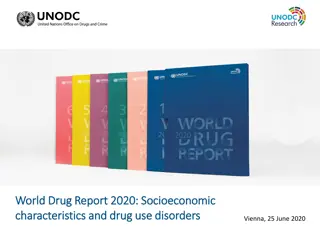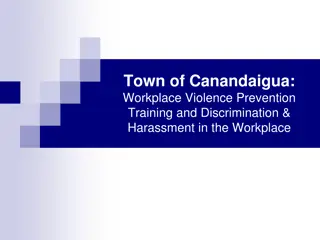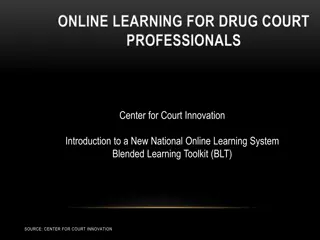Addressing Workplace Impairment and Drug Testing Challenges
Workplace impairment and drug testing present complex challenges affecting safety, productivity, and employee rights. Learn about initiatives, concerns, and potential solutions in New Zealand.
Download Presentation

Please find below an Image/Link to download the presentation.
The content on the website is provided AS IS for your information and personal use only. It may not be sold, licensed, or shared on other websites without obtaining consent from the author.If you encounter any issues during the download, it is possible that the publisher has removed the file from their server.
You are allowed to download the files provided on this website for personal or commercial use, subject to the condition that they are used lawfully. All files are the property of their respective owners.
The content on the website is provided AS IS for your information and personal use only. It may not be sold, licensed, or shared on other websites without obtaining consent from the author.
E N D
Presentation Transcript
Impairment versus workplace drug testing Sarah Helm Sarah Helm Gabrielle Colley Gabrielle Colley
Why is the NZ Drug Foundation interested in improving workplace testing? Keeping people in employment (and eduction). The harm of a job loss is usually far greater than the harm from drug use Preventing injury and accidents Current approach: Is ineffective, measuring presence of a drug not impairment Creates perverse incentives to use more harmful drugs Is implemented inconsistently Relies on substances being illegal, which will likely change in coming years
What are we doing? Trialling an impairment tool Working with 5 employers over the next 2 years OIAs to Worksafe and ACC don t keep a record of cause. Developing our own best practice workplace policy
How is impairment managed by Trades employers Insights and recommendations
Background & Problem Due to the high level of workplace fatalities and injuries in New Zealand the Health and Safety at Work Act 2015 (HSWA) was implemented. Under this Act all businesses have a primary duty of care to employee s health and safety at work and need to take all reasonably practicable steps to ensure it. To do so, business/employers need to protect employees against harm to their safety, welfare and health by eliminating and minimizing risks (Worksafe, 2022). Minimizing risks involve controlling hazards that an employee maybe exposed too that could cause harm. A hazard is defined as in the Health and Safety at Work Act (2015): Drug testing, specifically urine testing does not show if someone is impaired to do their job but past use of drugs urine is the most common test used Drug testing impinges on employees freedom s outside of working hours court judges can even acknowledge this Include[ing] a person s behaviour where that behaviour has the potential to cause death, injury, or illness to a person (whether or not that behaviour results from physical or mental fatigue, drugs, alcohol, traumatic shock, or another temporary condition that affects a person s behaviour). Drug testing can be a barrier to gaining employment and keeping employment Drug testing can contribute towards structural racism The underpinning is that workplace drug testing can improve safety and productivity by reducing the risk of accidents and incidents caused by alcohol and drugs, however workplace drug testing has become increasing commonplace and widespread for the management of impairment, without any conclusive evidence of its benefits. Drug testing is a very blunt tool in testing for impairment, or ability to do the job that the employee has been hired for. Unlike a breath test for alcohol, drug testing can detect previous drug use, but not current impairment. A positive test could indicate that an employee has smoked cannabis, or taken other drugs, sometime in the past month. Not only this but drug testing can be seen as contributing towards structured racism.
Scope Approach The NZ Drug Foundation provided guidance and feedback on the approach that was taken below to further investigate how impairment is managed in the trades industry within New Zealand Insight Analyse Recommendations Interview key industry contacts and trades employers management workplace impairment Pull out key theme s and insights from the interviews Provide recommendations on next steps on the of
Insight Interview methods Questionnaire development and data collection Limitations and analysis The participant pool was very small (only 30% of contacts who were reached out too responded and an interview was set up) however did reach a point of saturation in themes A draft questionnaire was developed for both those working in trades / construction companies and those who provide consultancy The questions were further refined by the NZ Drug Foundation until the set of finalised questions were approved There was an under-representation of trade employers The term trade was used to encompass all trades therefore findings are unable to illustrate any nuisances between trades and how impairment is managed NZ Drug Foundation and Massey University provided contacts and snowballing techniques were implemented to recruit interviewees Ahead of online virtual meetings the questions were sent to participants to enable them an opportunity to view and formalise answers 7
Participant recruitment & Analysis Participant Recruitment Insight Analysis No Name Company Position Contact 1 Francois Barton Zero Harm Executive Director Business Leaders H&S Forum Francois.barton@zeroharm.org.nz Snowballing technique was implemented to recruit participant for this investigation 2 Oliver Christeller First Union Lawyer oliver.christeller@firstunion.org.nz Contact 3 John from work safe advised he was not the correct fit for an interview and requested a Participant Information form (Appendix A) to circulate to other Worksafe contacts. I messaged twice but no one from Worksafe volunteered 3 John Fitzgerald Work Safe Manager Mentally Health Work Registered (Clinical) Psychologist John.fitzgerald@worksafe.govt.nz 4 Frank O Connor Moa Resources Organisational Psychologist frank@moa.net.nz 5 In Work Success Manager, Corporate Social Outcomes Lauri Shearman Downer New Zealand Lauri.Shearman@downer.co.nz +64 21 864 304 Contact 4 Frank Moa also advised he was not the right fit but provided the contacts 5-12 *Frank Moa contact 6 Jan O Neill Downer NZ Executive General Manager People & Culture Jan.O'Neill@downer.co.nz +64 27 270 2867 Contacts 5-12 were all emailed with the participant information sheet however only contact 5, Lauri emailed back and an interview was set up. 7 Sue Perry Fletcher Construction Company People and Performance Business Partner +64 21 554 532Email unknown 8 Janette Love Fulton Hogan HCM Lead janette.love@fultonhogan.com Contact 5 Lauri Shearman provide contact 13 Donna Wilson 9 Bill Caradus Fulton Hogan National Manager Bill.Caradus@fultonhogan.com 10 Pam McGarry Naylor Love General Manage pam.mcgarry@naylorlove.co.nz +64 27 477 4135 11 Aimee Dolphin Fletcher Construction Company People and Performance Business Partner aimee.dolphin@nx2.co.nz+64 27 263 4597 12 Matt Williams Carters GM/Operations Manager Matt.Williams@carters.co.nz 8 13 Donna Wilson McConnell Dowell Constructions LTD HR Advisor Donna.Wilson@mcdgroup.com
Executive summary: Impairment in the Trades Theme s from the questionnaire revealed three key insights on how workplace impairment could be managed better: Impairment Workplace Culture Multifaceted Approach The term impairment is an umbrella term used to represent all forms of impairment. Due to this there are a lack of succinct frameworks for the varying forms of impairment therefore individual frameworks around each form could be developed Changing how impairment is managed starts with changing the workplace culture around impairment Alert metre may help to do this A multifacted approach to managing imprirment needs to be implemented that address laws, frameworks, process & procedures. Implements other tools, educates that can all assist in a cultural shift 9
Current State It s important to consider New Zealand s current context and how widespread workplace drug and alcohol impairment is or is not: Analyse The scale of the issue is unknown Trades Union Lawyer: The drug cases I ve been involved in, which is quite a lot. There is no data available on how many trades/construction employees get dismissed because of drug & alcohol impairment or how many accidents occur because of it Not all of them, but more than 95% which is a vast majority of them, are for cannabis ACC Data Drug use Data ACC do not inquire for workplace injuries and how an accident happened, just that it did happen. 12% of 15+ Kiwis used cannabis in the past year. They did a search of free text for various drug and alcohol words such as drunk, intoxicated, and some specific drug names 10 *Ministry of Health: Health Survey
Analyse Questionnaire Theme 1: Absence of good frameworks What participants said: All forms of impairment are grouped together and not managed succinctly So the absence of good frameworks that let us understand the different approaches to how we can understand and therefore manage impairment is a problem. It was indentifed and acknowledged that impairment is an umbrealla term used to group the varying types of impairment. We haven t got a very useful and agreed set of standards in a global sense. There is psychosocial impairment, there is substance induced impairment , there is a bunch of these impairment elements and because we have not really lifted the conversation to, or we are clear around what we mean by impairment, what do we mean by different causes of impairment, how do we understand how to manage those different levels of impairment and types of impairment. Due to the lack of categorization within impairment it makes managing the varying types of impairment difficult There seems to be no real way to managing any of those other hazards, mental fatigued or trauma, or very few that are effective ways to manage those. 11
Analyse Questionnaire Theme 1: Absence of law development What participants said: Law changes are slow to happen Feeding into this theme is the law that sits above the framework There have been some developments but the developments in NZ law at this point probably as great as you might imagine. Its partly because we are a small jurisdiction , partly because the union movement is probably not as big and that workers on their own cannot resource these cases. Particularly by the time you get into the court you are talking $20k a day and costs the other side if you loose, let alone organising your own representation. A lot of these cases are not worth a hell of a lot of money, Even if you win them there is a dismissal cases. So the economics don't make sense, unless your trying to advance the law often, not always. More cases of drug and alcohol impairment needs to be put in front of judges to advance the law the issue is that individuals cannot afford to fund these cases There have been several cases (2012 Goodman Food Company, 2009 Parker & Silverfern) where judges acknowledge the impingement of employee sfreedom s drug & alcohol testing has extract from Goodman Food trial: The court is quite open about the fact, that they want to see more cases come through, particular in certain areas. I think judges sometimes get frustrated that, they cannot develop the law, until the set of facts presents themselves of course, because that is their role to comment on. Make decision based on the facts that come before them. Which does feed in, well if we are not getting sufficient legal development through case law, then there is a question about should the government be more pro-active in that space? The employer has a legitimate right (and indeed obligation) to try and eliminate the risk that employees might come to work impaired by drugs or alcohol such that they could pose a risk to health or safety. Beyond that the employer has no right to dictate what drugs or alcohol its employees take in their own time. Indeed, it would be unjust and unreasonable to do so 12
Analyse Questionnaire Theme 2: Workplace Culture & Values Positive culture shift where people feel like they are safe Drug testing is about catching people out All participants identifed that a culture shift is required from catching people out to creating an environment where people feel safe to step forward and say they are not okay to work. I think there is still, maybe a workplace values issue where it is seen as much as a moral failing in some cases as it a compliance issue and that it sits in a sanction type mindset. Sits in a punitive space that actually doing that is wrong and that there should be consequences for it being wrong. It was noted that this is a long term soltuon and sits with management to initate the change If you have a culture that is looking after people and supporting people, um and not taking the biggest, hardest stick possible then you may find more effective way of managing impairment. 13
Analyse Questionnaire Theme 3: Education The agencies tend to be both the testers and the people who assist and develop the policy, like one stop shop. The problem is that they have capital investment, in urine tests and they do, you know, just from a pure business perspective. If you have a capital investment, you don t really want to give it away, a device that renders your investment obsolete. Educate the industry on impairment testing & companies that carry them out It was reiterated that tetsing companies have a capital investment which causes a conflict of interest It was acknowledged that companies may not always be getting good advice on impairment testing due to this conflict You ve got a whole lot of drug detection firms that are currently making their money out of urine-based testing They are not always getting Good advice. Well, they are getting advice that is painted, wider anti-drug views. Which of course, some of the employers actually have themselves 14
Recommendations Reach out wider More interviews Get the unions involved Talk to Fonterra More interviews are required with Trades Employers, especially both smaller business + larger companies. Interviews were difficult to generate as the response rate was so low. Contacts who did not respond could be contacted again Fonterra has now implemented saliva testing (most NZ companies use urine) discuss how this was implemented & how they use it & any benefits It is recommended branch out to union leaders within the sector. Diary workers union contact provided mark@dwu.nz 15
Recommendations Alert-metre Conduct a POC Additional tool for Wellbeing Introduce the Alert meter as a supplementary tool for impairment opposed to a substitute for drug and alcohol testing. Frame it from a well-being perspective. Look at high incidents periods e.g. Christmas & implement the tool as a supplementary tool during these high-incident periods Alert-metre framing Donna Wilson at McConnell Dowell Constructions LTD advised she would like to trail the Alert-metre Alert-metre tests for varying forms of impairment trial the application as testing for fatigue / stress. 16
Recommendations Collate Data & investigate the Scale & Educate Work with Trade Union Laywers Educate the industry Work with Patrick Gower? Patrick Gower is an investigative journalist who explores drug and alcohol issues in NZ Investigate the scale of previous cases to collate better and accurate data. ACC data investigated however did not yield any significant results apart from stress related claims are the most It has been flagged that workplaces are obtaining their information from the urine screening agencies and therefore have a reluctance to change to oral testing take the learnings form Fonterra & start to target other big industries e.g. Silver Fern Farms has been 17
